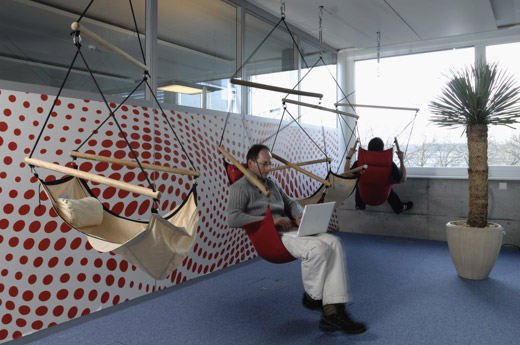HDR Architecture Health Design Interventions
Consider these statistics: Annual revenues for U.S. home fitness equipment manufacturers reached about $3 billion last year while the health club industry enjoyed revenues of $20.3 billion. Now ponder this: The number of Americans between the ages of 20 to 74 classified as obese rose almost threefold, from 13.3 percent to 39.5 percent, in the past three decades. Expand this figure to include the merely overweight and it jumps to a staggering 73.7 percent – seven out of every 10 Americans.
As a healthcare architect, I know all too well how obesity sets the stage for a host of medical problems. The Rand Corporation reports severely obese people are more than twice as likely as normal weight people to be in fair or poor health. And, they have about twice as many chronic conditions. This translates into higher healthcare costs – 69 percent higher for men, 60 percent higher for women. Obesity has also been linked to increased risk of all-cause mortality. The U.S. Department of Health and Human Services reports more than 300,000 deaths each year are associated with being overweight and obese. Some estimates indicate that 89.5 million healthcare facility bed days are directly related to obese patient care. Another study predicts obesity-related diseases could generate $344 billion in healthcare costs by 2018.
Clearly the existing paradigm is not working. We need a new perspective to identify solutions to our nation’s weight problems – including a look at how we design our buildings and communities. A growing body of research indicates our physical environments have a substantial impact on the health and well-being of the people for whom we design.
“One challenge is to better understand the broad impact of our built environment on health and then to build future communities that promote physical and mental health,” wrote Richard Jackson, M.D., MPH, in his guest editorial, “The Impact of the Built Environment on Health: An Emerging Field,” in the September 2003 issue of the American Journal of Public Health. “Public health has traditionally addressed the built environment to tackle specific health issues such as sanitation, lead paint, workplace safety, fire codes and access for persons with disabilities. We now realize that how we design the built environment may hold tremendous potential for addressing many of the nation’s greatest current public health concerns, including obesity, cardiovascular disease, diabetes, asthma, injury, depression, violence and social inequities,” he contends.
The good news is the awareness connection between the built environment and health is growing. A number of recent initiatives are taking a serious look at how we design communities and buildings to positively and measurably influence physical well-being and health.

Photograph courtesy of Google|Communal spaces at Google Zurich offices include swings & slides.
One such initiative is the American Institute of Architects’ (AIA) America’s Design and Health Initiative (ADHI). ADHI is working toward three key deliverables – a body of evidence, a research agenda and policy recommendations – for architects, public health officials and policymakers.
“This information will be used to build a foundation for influential, ongoing dialog on the connections between physical activity, obesity, design and health,” writes Markku Allison, AIA, Resource Architect with the AIA Center for Value of Design. “By clearly demonstrating connections between design and beneficial health outcomes, ADHI will give architects an important new value proposition for the society we serve,” he explains.
Other noteworthy initiatives include:
- The AIA Academy of Architecture for Health recently revised its bylaws this year to reflect a mission not only centered on healthcare facilities, but also on creating healthy communities.
- The Robert Wood Johnson Foundation, a New Jersey-based philanthropy, kicked off a $25 million “Active Living by Design” initiative to fund infrastructure changes, walking clubs and other efforts in 25 communities.
- In Atlanta, the Georgia Institute of Technology, the Centers for Disease Control and Prevention (CDC) and others are working together to study how, when and where people tread. The one-year study involves surveying 8,000 Atlanta-area residents and placing about 1,000 of them on electronic devices that track where and how often they walk.
- The CDC funded the University of Virginia School of Architecture’s Public Health + Built Environment Course Curriculum, which offers an interdisciplinary undergraduate, graduate or continuing education curriculum in public health and built environment.
- Design for Health (DFH), a collaborative project between the University of Minnesota, Cornell University and the University of Colorado, is serving to bridge the gap between the emerging research base on community design and healthy living, and the everyday realities of local government planning. The project has assisted 19 cities and counties in Minnesota preparing comprehensive plans, transportation plans and other guidelines and ordinances.
One of the most recent initiatives is New York City’s Active Design Guidelines, which provides architects and urban designers with a manual of strategies for creating healthier buildings, streets and urban spaces, based on the latest academic research and best practices in the field. It includes: urban design strategies for creating neighborhoods, streets and outdoor spaces that encourage walking, bicycling and active transportation and recreation; and building design strategies for promoting active living through the placement and design of stairs, elevators and indoor and outdoor spaces.
In a February 23, 2010 article on FastCo.com, urban designer and architect Jack L. Robbins described the Active Design Guidelines as the beginning of a “strategic shift” in the battle to get Americans to exercise. “Instead of trying to change individual choices by using a moral appeal about what is good for us (you should walk to work because it is better for you), it’s about changing the environment to reshape the available choices (you’ll want to walk because it is easier, cheaper, faster or more enjoyable). This strategy recognizes that the public’s underlying motivations are not about health but, rather, about what is convenient and enjoyable,” he commented.
Robbins was absolutely right; playing to the convenience and fun factors are essential when designing spaces, which impact the health and well-being of people who use them. For example, the design team at Camenzind Evolution got employees moving in the new Google Zurich offices with a variety of highly stimulating communal areas and meeting spaces. These included one with swings, another with a slide between a floor of workspaces and one with the employee café.

Photograph courtesy of Google
At the new Fort Belvoir Community Hospital, six different healing gardens entice ambulatory patients to leave their hospital rooms and walk outside, thus connecting them to the valuable healing properties of nature. In addition, the gardens connect to a series of walking trails, making it as convenient as possible to keep on walking once outside.
The fact of the matter is that architects and designers are the newest public health officials in the war against obesity. Their ammunition: major design interventions focused on the health of users. The rising trend toward obesity is not something we can reverse overnight. But, with a greater awareness of how the physical environment impacts health and well-being, we will be better able to design a healthier future for all.




























